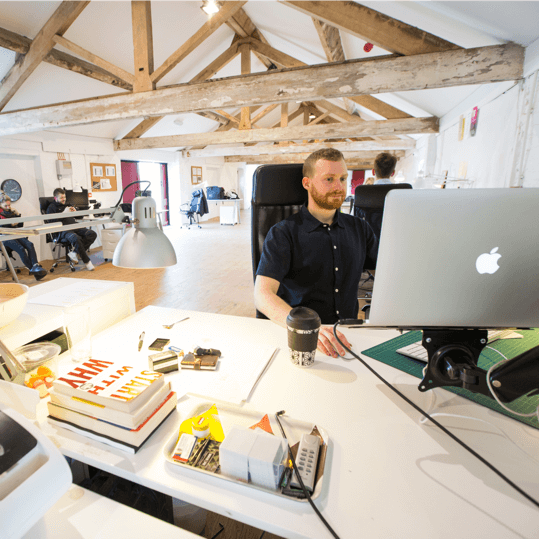Website readability is one of the most important factors that influence user engagement, conversions, and overall digital experience. When visitors land on your website, their first impression is shaped by how easily they can consume your content. Even the most informative article or beautifully written copy will fail to make an impact if the layout is cluttered, confusing, or visually overwhelming.
This is why understanding how to improve website readability with layout choices is essential for businesses and designers who want to enhance user satisfaction and build trust online. A well-structured layout plays a central role in modern web design and web development, ensuring that content is accessible, visually balanced, and easy to navigate.
Why Layout Matters for Readability
A website’s layout determines how information flows across the page. It guides the user’s eye movement, prioritizes key content, and reinforces the brand’s digital identity. When readability is high, users spend more time on the site, bounce rates decrease, and conversion rates improve.
Effective layout choices:
Organize content logically
Make text easier to scan
Reduce cognitive load
Increase user engagement
Improve accessibility
In both web design and web development, focusing on readability ensures that your message reaches users clearly and efficiently.
1. Use Clear Typography and Consistent Font Sizes
Typography is one of the most critical elements affecting readability. Choosing the right font style, size, and spacing can significantly improve user experience.
Key typography tips:
Use fonts that are simple and highly legible (e.g., sans-serif fonts).
Maintain a consistent font size hierarchy—larger headings, medium subheadings, and readable body text.
Ensure adequate line spacing (1.5–1.75) to reduce clutter.
Avoid decorative fonts for body text.
Good typography supports the overall layout and complements your web design strategy by making content more inviting and readable.
2. Include Adequate White Space for Balance
White space (or negative space) is the empty area between text, images, and other design elements. It helps users focus on the content by preventing visual overload.
Benefits of white space:
Enhances content clarity
Makes layouts more breathable
Improves scanning and navigation
Creates a clean, modern design
In web development, proper spacing also contributes to responsive design, ensuring that layouts adjust seamlessly across devices.
3. Choose a Grid-Based Layout for Structure
Grid systems are widely used in modern web design because they help maintain visual consistency and alignment. A grid creates a predictable structure, allowing users to follow content naturally.
Why grids improve readability:
They create a balanced rhythm in content presentation.
They keep text blocks aligned and evenly spaced.
They make pages look organized and professional.
Whether you’re creating landing pages, blog layouts, or product pages, grids enhance both usability and readability.
4. Use Contrast to Highlight Important Content
Contrast improves readability by ensuring that text stands out from the background. Poor contrast can strain users’ eyes and make reading difficult, especially on mobile devices.
Effective contrast techniques:
Use dark text on a light background or vice versa.
Highlight key sections with contrasting colors or bold fonts.
Ensure buttons and links stand out clearly.
High contrast is not just a visual choice—it’s also an accessibility requirement that affects both web design and web development.
5. Break Text into Digestible Sections
Large blocks of text are intimidating. To improve readability, break content into smaller paragraphs, add subheadings, and use bullet points where appropriate.
Best practices for content organization:
Keep paragraphs 2–4 lines long.
Use descriptive subheadings to guide readers.
Add lists to summarize important points.
Include visuals to break up large text areas.
This layout strategy helps users skim content quickly and find the information they need without frustration.
6. Optimize Layout for Mobile Devices
With most users accessing websites through their phones, mobile readability has become a priority in web development.
Mobile readability enhancements:
Use responsive layouts that adapt to all screen sizes.
Ensure touch-friendly spacing between elements.
Choose font sizes that remain readable on small screens.
Avoid horizontal scrolling.
A mobile-friendly design ensures consistent readability whether users browse on a smartphone, tablet, or desktop.
7. Use Visual Hierarchy to Guide Users
Visual hierarchy directs attention to the most important elements on your website. By adjusting size, spacing, color, and placement, you can control how readers interact with your content.
Techniques include:
Larger headings for major topics
Strategic use of color for emphasis
Highlighted call-to-action buttons
Eye-catching banners or hero sections
This helps users navigate intuitively, leading to better retention and smoother browsing.
8. Combine Layout Choices with Strong Web Design Principles
Improving readability is not just about placing elements correctly—it’s about integrating layout choices with broader web design principles like accessibility, brand consistency, and user experience design.
When combined with strong development practices, good layout choices help websites load faster, function better, and provide a seamless user experience from top to bottom.
Conclusion
Knowing how to improve website readability with layout choices is essential for creating user-friendly digital experiences. By focusing on typography, spacing, contrast, mobile responsiveness, grid structures, and visual hierarchy, you can build a website that communicates clearly and keeps visitors engaged.
In an increasingly competitive online space, integrating readability-focused layout techniques into your web design and web development workflows can significantly boost usability, accessibility, and customer satisfaction. A well-designed layout doesn’t just improve how a website looks—it transforms how users interact with and understand your content.




